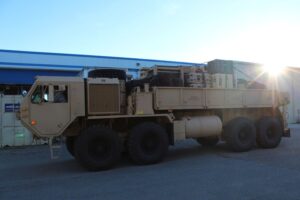HUNTSVILLE, Ala. — The Army is set to begin fielding its first unit with the Northrop Grumman [NOC]-built Integrated Air and Missile Defense Battle Command System (IBCS) this December, a lead official confirmed on Monday, as an increasing number of international partners, including Germany and Japan, are expressing interest in the new command and control capability.
“We have been laser focused on fielding IBCS to the operational force,” Col. Chris Hill, the Army’s program manager for integrated fires mission command, told reporters during a media visit to the Northrop Grumman’s Huntsville Manufacturing Center where it produces IBCS’ components. “[Northrop Grumman] is on the precipice of fielding a system to the Army that is, by far, going to be the best air defense system in the world.”

Following delivery of the first IBCS kit to 3rd Battalion,43rd Air Defense Artillery Regiment in December, Hill said the Army will move into follow-on operational and evaluation by February 2025 as it aims to field a second battalion and work to complete deliveries to a third by July 2025.
“We’re going to field the first three battalions in pretty rapid succession. As you know when it comes to modernization, some of [the fielding schedule] has to do with op tempo. So, as units become available, that’s when they are modernized. And the Patriot [system] has a very high op tempo. You can’t pull a unit out of the fight to modernize. You’ve got to wait until they redeploy,” Hill said.
IBCS is the Army’s future missile defense command platform, designed to integrate and connect the service’s full range of “sensor to shooter” capabilities, with Hill noting the Army to date has integrated the Sentinel A3 radar, Patriot radar, the new LTAMDS radar, the Indirect Fire Protection Capacity effector with the system.
Hill also addressed the slight shift in the planned IBCS’ initial fielding schedule, which the Army had planned to target for the end of FY ‘24.
“Four or five months ago we had a fielding conference and we looked at the availability of units. We looked at the availability of the actual IBCS systems,” Hill said. “This was an opportunity to actually delve into the dirty details of when the units were going to be available and when they needed the kit to be in their hands. So even though it looks like IBCS may have moved to the right, if you were to look at our fielding schedule we stayed on time from a fielding schedule standpoint only because of some of the more detailed planning we did in accordance with the users.”
The Army began receiving the first major production components for IBCS in December, accepting deliveries of the Integrated Collaborative Environment, while Northrop Grumman officials told reporters during the visit that the first Integrated Fire Control Network Relays and Engagement Operations Center will be delivered by the end of April (Defense Daily, Feb. 2).
On the increasing international interest, Hill said the Army has had “several conversations” with Germany and Japan about IBCS, to include discussions on how the system would potentially operate with each country’s existing suite of sensors and effectors.
“[It’s] to the point where now we’re starting to have more detailed classified discussions,” Hill said. “It’s important that we allow them to understand that you may have radars that you produce in your country, you may have shooters that you produce in your country, we can integrate those into IBCS. You don’t have to throw away those capabilities.”
Ian Reynolds, vice president of Northrop Grumman’s C4 missile defense business unit, told reporters that a recent memorandum of understanding signed with Germany’s Diehl Defence GmbH & Co. KG to work together on layered air and missile defense capabilities and a new teaming agreement with Japan’s Mitsubishi Electric Corporation to collaborate on creating a networking solution for Japan’s ground-based integrated air and missile defense systems have provided forums for the two nations’ exploratory interest in IBCS (Defense Daily, March 15).
Beyond Germany and Japan, Hill noted that countries such as Switzerland, the Netherlands and Saudi Arabia have shown interest in IBCS.
“We have many countries that are very, very interested in what we’re doing. And some of what we’re talking about right now is what they want to hear. They want to know, ‘How far along is the Army? Are you really about to field this?’ So that’s why it’s important for us to show them evidence that IBCS can do what we had always envisioned it to be able to do,” Hill said.
The growing international interest in IBCS follows Poland’s procurement of the system for its air and missile defense modernization initiatives, with Bill Lamb, Northrop Grumman’s IBCS director, noting the country now has a squadron’s worth of equipment and is set to achieve initial operational capability by mid to late-summer.
“Our expectation is that [potential international interest] will move faster from going to agreement to actual contract award. I don’t want to speak for the U.S. government relative to their acquisition approach. But our expectation is once you’ve got one international partner that’s worked through this process, that it’ll go quicker [with others],” Lamb said, when asked if Poland can serve as a blueprint for other countries’ pursuit of IBCS.
Poland signed on to become the first international IBCS operator after agreeing to a $4.75 billion deal with the U.S. in March 2018 to purchase the Patriot missile defense system along with the new Northrop Grumman-built battle command system in support of the first phase of its WISLA air and missile defense modernization program (Defense Daily, March 28, 2018).
Earlier this month, Poland and the U.S. signed a new agreement worth approximately $2.5 billion for additional future deliveries of IBCS for the NAREW short-range air defense modernization program and the second phase of WISLA air and missile defense upgrade effort (Defense Daily, March 1).